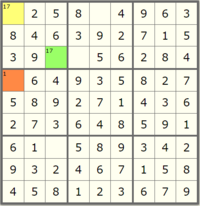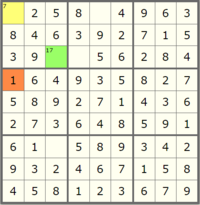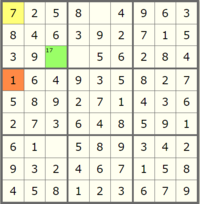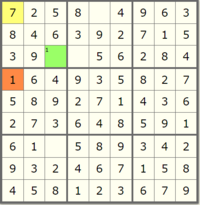Sudoku Constraint Propagation
Contents
Constraint Propagator
| class: | DefaultConstraintPropagator.java | |
| methods: | createCandidateSetsFromGivens createNextCandidateSets assign eliminate |
|
| package: | sudoku.lab | |
| source folder: | student/src/main/java |
You will need to implement two public methods to satisfy the ConstraintPropagator interface: createCandidateSetsFromGivens and createNextCandidateSets. Each of these two methods will be invoked from a different constructor in the #DefaultImmutableSudokuPuzzle class. It should be relatively obvious which one goes with which based on the parameters.
createCandidateSetsFromGivens
method: public Map<Square, SortedSet<Integer>> createCandidateSetsFromGivens(String givens) ![]() (sequential implementation only)
(sequential implementation only)
This method will be invoked when you have loaded a new puzzle. Whether it is from the newspaper, or your airline magazine, or Dr. Arto Inkala there is a set of givens the puzzle creator has provided. That string of givens is parsed into a Map from Square to Optional<Integer>. If a square is given (that is it has a specified starting value) the Optional will be present and its value will be set. If a specific spot of the board wasn't given in the input, it will be empty.
new EnumMap<>(Square.class) for an EnumMap of Squares. |
A good approach here is to start of by initializing all of the squares to all the options (1 through 9) whether or not the square has a given value.
Square.values() is useful here for iterating over all of the Square enum constants. |
CandidateSet.createAllCandidates() is useful here when looking to start a square's candidates off at [1,2,3,4,5,6,7,8,9]. |
Once that is complete go through the givens and get your private method(s) to work for you.
createNextCandidateSets
method: public Map<Square, SortedSet<Integer>> createNextCandidateSets(Map<Square, SortedSet<Integer>> otherCandidateSets, Square square, int value) ![]() (sequential implementation only)
(sequential implementation only)
This method should be invoked when you are searching for the solution in your solver. Much like when you need to create a new copy of the board every time you make a decision in the n-queens search so too will you need to create a new copy of your sudoku board every time you make a decision in your backtracking search.
Make sure to use the SudokuUtils.deepCopyOf method and refrain from mutating the incoming parameter otherCandidateSets.
As warned above, do not actually do any of the constraint propagation in this method. Simply get the copy of the options set, then leverage your private assign method (which in turn may leverage eliminate) to update the copy to be correct before returning it.
a and b, and you set a = b, then any changes you make to a will also be made to b. Both variables reference the same objects; they are not copies. |
Assign and Eliminate
Background
Peter Norvig's Essay is very helpful here. We have adopted his terms, but challenge yourself to complete this section without simply translating his pseudocode.
To simplify things a bit, we have elected to not short circuit when a 0 option square is found (relying on the search ordering to take care of that for us).
It is up to you how to utilize these two methods. The goal is to update the map that is passed in to reflect the "solving" of a square. For example, if assign is called on square A1 for the value 1, the map that is returned should link the square A1 to a list containing just the value 1 ([1]). Furthermore, any square that is a peer of A1 (ex. B1), should not have the value 1 in its set in the map.
But in solving Sudoku, there are some strategies that we can rely on to more efficiently complete the puzzle. The first one, and required in order to finish this lab, is Peer Elimination Constraint Propagation (rule 1 in the Norvig essay). The rule is as follows: "If a square has only one possible value, then eliminate that value from the square's peers."
Let's very slowly walk through a example of this propagation in detail to make it more clear what we are looking for. Start by looking at this nearly finished board:
Two Paths
All Assign All The Time
In this implementation, you will perform all of your work in the assign method. eliminate will never be invoked.
Mutual Recursion
In this implementation, assign and eliminate will take on their own roles, at times calling each other. This implementation leads nicely into the extra credit portion.
assign(resultOptionSets,square,value)
method: private void assign(Map<Square, SortedSet<Integer>> resultOptionSets, Square square, int value) ![]() (sequential implementation only)
(sequential implementation only)
eliminate(resultOptionSets,square,value)
method: private void eliminate(Map<Square, SortedSet<Integer>> resultOptionSets, Square square, int value) ![]() (sequential implementation only)
(sequential implementation only)



